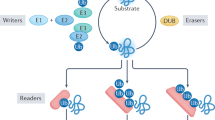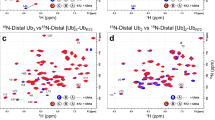Abstract
My interest in protein breakdown as a research problem began in 1955. In 1963, when we relocated from Yale to the Institute for Cancer Research of Fox Chase, Philadelphia, nothing new was being reported. Here, I review how we get the ubiquitin proteasome system all together.
Similar content being viewed by others
Log in or create a free account to read this content
Gain free access to this article, as well as selected content from this journal and more on nature.com
or
Abbreviations
- APF-1:
-
ATP-dependent proteolysis factor 1
- DUB:
-
deubiquitinating enzyme
- UCH:
-
Ub-carboxy-terminal hydrolase
References
Schoenheimer R (1942) The Dynamic State of Body Constituents Cambridge, MA: Harvard Press
Schimke RT and Doyle D (1970) Control of enzyme levels in animal tissues. Annu. Rev. Biochem. 39: 929–976
Simpson MV (1953) Control of enzyme levels in animal tissues. J. Biol. Chem. 20: 143–154
See previous autobiographical chapter
Rose IA et al. (1974) Determination of the rate of hexokinase-glucose dissociation by the isotope-trapping method. J. Biol. Chem. 249: 5163–5168
Etlinger JD and Goldberg AL (1977) A soluble ATP-dependent proteolytic system responsible for the degradation of abnormal proteins in reticulocytes. Proc. Natl. Acad. Sci. USA 86: 7751–7755
Ciechanover A, Hod Y and Hershko A (1978) A heat-stable polypeptide component of an ATP-dependent proteolytic system from reticulocytes. Biochem. Biophys. Res. Commun. 81: 1100–1105
Hershko A, Ciechanover A, Heller H, Haas AL and Rose IA (1980) Proposed role of ATP in protein breakdown: conjugation of proteins with multiple chains of the polypeptide of ATP-dependent proteolysis. Proc. Natl. Acad. Sci. USA 77: 1783–1786
Wilkinson KD, Urban MK and Haas AL (1980) Ubiquitin is the ATP-dependent proteolysis factor I of rabbit reticulocytes. J. Biol. Chem. 255: 7529–7532
Haas AL, Murphy KE and Bright PM (1985) The inactivation of ubiquitin accounts for the inability to demonstrate ATP, ubiquitin-dependent proteolysis in liver extracts. J. Biol. Chem. 260: 4694–4703
Haas AL, Warms JVB, Hershko A and Rose IA (1982) Ubiquitin-activating enzyme. Mechanism and role in protein–ubiquitin conjugation. J. Biol. Chem. 257: 2543–2548
Haas AL and Rose IA (1982) The mechanism of ubiquitin activating enzyme. A kinetic and equilibrium analysis. J. Biol. Chem. 257: 10329–10337
Haas AL, Warms JVB and Rose IA (1983) Biochemistry 22: 4388–4394
Hershko A, Ciechanover A and Rose IA (1981) Identification of the active amino acid residue of the polypeptide of ATP-dependent protein breakdown. J. Biol. Chem. 256: 1525–1528
Rose IA and Warms JVB (1983) Biochemistry 22: 4288–4294
Pickart CM and Rose IA (1985) Ubiquitin carboxyl-terminal hydrolase acts on ubiquitin carboxyl-terminal amides. J. Biol. Chem. 260: 7903–7910
Pickart CM and Rose IA (1986) Mechanism of ubiquitin carboxyl-terminal hydrolase. Borohydride and hydroxylamine inactivate in the presence of ubiquitin. J. Biol. Chem. 261: 10210–10217
Johnston SC, Riddle SM, Cohen RE and Hill CP (1999) Structural basis for the specificity of ubiquitin C-terminal hydrolases. EMBO J. 18: 3877–3887
Hu M, Li P, Li M, Li W, Yao T, Wu J-W, Gu W, Cohen RE and Shi Y (2002) Crystal structure of a UBP-family deubiquitinating enzyme in isolation and in complex with ubiquitin aldehyde. Cell 111: 1041–1054
Johnston SC, Larsen CN, Cook WJ, Wilkinson KD and Hill CP (1997) Crystal structure of a deubiquitinating enzyme (human UCH-L3) at 1.8 Å resolution. EMBO J. 16: 3787–3796
Acknowledgements
It is a pleasure to pay tribute to Dr. Avram Hershko, whose analytic intuition was always productive and whose generous spirit made our interactions always harmonious. The post-docs: Aaaron Ciehanover, Art Haas, Cecile Pickart, and Keith Wilkinson were all major contributors who have continued their careers in the Ub field with notable success. Thanks are also due to Hannah Heller and Jesse Warms for their contributions in the lab. This review was obtained thanks to the kind help of the Nobel Foundation in Stockholm, http://nobelprize.org (© The Nobel Foundation 2004).
Author information
Authors and Affiliations
Corresponding author
Additional information
Edited by G Melino
Nobel Lecture 2004, © The Nobel Foundation 2004
Rights and permissions
About this article
Cite this article
Rose, I. Ubiquitin at Fox Chase. Cell Death Differ 12, 1198–1201 (2005). https://doi.org/10.1038/sj.cdd.4401710
Received:
Accepted:
Published:
Issue date:
DOI: https://doi.org/10.1038/sj.cdd.4401710
Keywords
This article is cited by
-
The ubiquitin proteasome system and its involvement in cell death pathways
Cell Death & Differentiation (2010)
-
In the beginning there was RNA, then came transcription regulation: the Nobel Prize Lectures 2006
Cell Death & Differentiation (2007)



